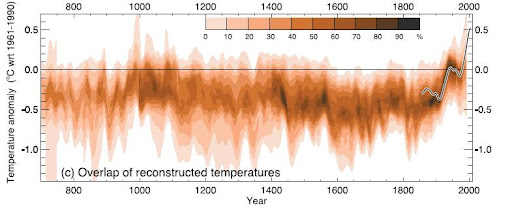It writes itself
Ethon, after sharing a hardy liver plant snack with Tim Lambert flew on to his new roost at Climate Feedback where von Storch and Zorita are engaged in a tag team match with McIntrye and McKitrick, whacking each other with broken hockey sticks for honors. Lubos Motl and others sitting in the front row join in.
There have been a lot of reconstructions since 1998, most of them since 2001 when the TAR was published. Eli thought he would go see what the new WG I report says about all this. We are used to the spaghetti graph, but the AR4 has a nice way of showing the overlaps between the various studies
 Section 6.6.1.1 can't make the M&M boys very happy
Section 6.6.1.1 can't make the M&M boys very happy
McIntyre and McKitrick (2003) reported that they were unable to replicate the results of Mann et al. (1998). Wahl and Ammann (2007) showed that this was a consequence of differences in the way McIntyre and McKitrick (2003) had implemented the method of Mann et al. (1998) and that the original reconstruction could be closely duplicated using the original proxy data. McIntyre and McKitrick (2005a,b) raised further concerns about the details of the Mann et al. (1998) method, principally relating to the independent verification of the reconstruction against 19th-century instrumental temperature data and to the extraction of the dominant modes of variability present in a network of western North American tree ring chronologies, using Principal Components Analysis. The latter may have some theoretical foundation, but Wahl and Amman (2006) also show that the impact on the amplitude of the final reconstruction is very small (~0.05°C; for further discussion of these issues see also Huybers, 2005; McIntyre and McKitrick, 2005c,d; von Storch and Zorita, 2005).and we can see why von Storch and Zorita have their knickers in a twist on p 473
Tasty
Using pseudo-proxy networks extracted from GCM simulations of global climate for the last millennium, von Storch et al. (2004) suggested that temperature reconstructions may not fully represent variance on long time scales. This would represent a bias, as distinct from the random error represented by published reconstruction uncertainty ranges. At present, the extent of an such biases in specific reconstructions and as indicated by pseudo-proxy studies is uncertain (being dependent on the choice of statistical regression model and climate model simulation used to provide the pseudo-proxies). It is very unlikely, however, that any bias would be as large as the factor of two suggested by von Storch et al. (2004) with regard to the reconstruction by Mann et al. (1998), as discussed by Burger and Cubash (2005) and Wahl et al. (2006). However, the bias will depend on the degree to which past climate departs from the range of temperatures encompassed within the calibration period data (Mann et al., 2005b; Osborn and Briffa, 2006) and on the proportions of temperature variability occurring on short and long time scales (Osborn and Briffa, 2004). In any case, this bias would act to damp the amplitude of reconstructed departures that are further from the calibration period mean, so that temperatures during cooler periods may have been colder than estimated by some reconstructions, while periods with comparable temperatures (e.g., possible portions of the period between AD 950 and 1150, Figure 6.10) would be largely unbiased. As only one reconstruction (Moberg et al., 2005) shows an early period that is noticeably warmer than the mean for the calibration period, the possibility of a bias does not affect the general conclusion about the relative warmth of the 20th century based on these data.





5 comments:
It's all too funny. All too sad. Like watching two teams of flat-eathers arguing whether the end of the Earth is bound by a boundless ocean, or an endless precipitice.
Mus musculus anonymouse
Climate Feedback?
I think Climate Fleabag would be a better description.
It's interesting to see the 1999 Mann results overlapped with the above graph.
If the darkest region is taken as the most likely temp reconstruction, that actually makes the blade of the hockey stick more prominent since the "combination-handle" is down closer to -.5 (between about -.25 and -.5) for most of the time period, while the "Mann-handle" was between -.25 and 0 for most of the same period.
I still say it looks more like a scythe.
-- Mr. Bones
Use your eyes,
The medieval warm period is documented all over the world in written records and pictorially, so is the Little ice age, they did exist and Mann and Co should accept that. Proxies only show a temperature trend, 0.6 of a degree in 100 years, rubbish. Take a temperature reading on a sunny day at the bottom of your garden, then do the same against the wall of your house, that`s called the urban heat effect. If there is a temperature rise it is natural, as for a global average temperature it can`t be measured even if it existed.
If you do believe past temperature records are correct you should also accept Becks 180 year of Co2 records they show over 450 ppm of CO2.
Rob.
Post a Comment